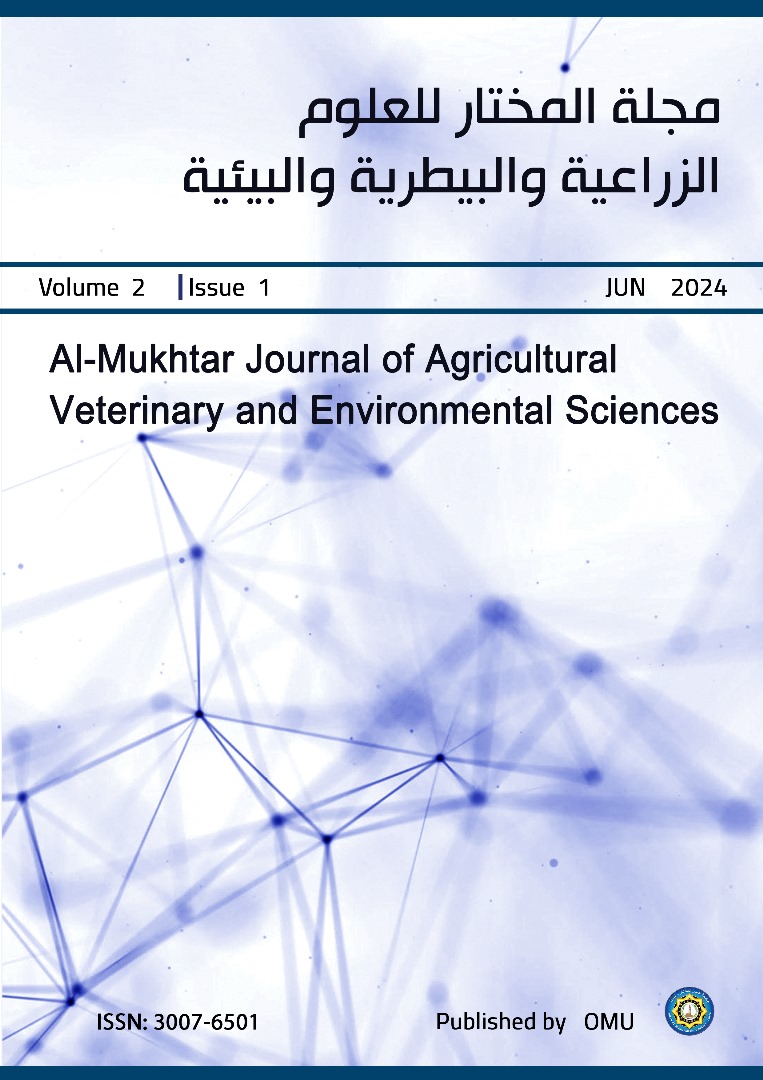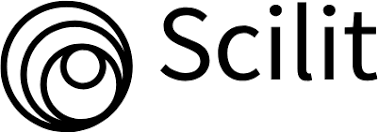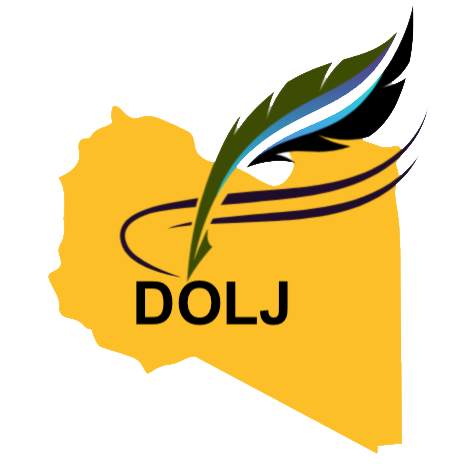Mycoflora Detection in Some Dry Plants Used in Libyan Folk Medicine
DOI:
https://doi.org/10.54172/vrt21p67Keywords:
Medicinal Plant, Moisture content, Fungi, Mycotoxins, LibyaAbstract
laurel Bay, Guava and Senna were purchased from different herbalist shops in Al-Beyda city. Moisture content was determined, and the levels of fungal contamination were detected in all samples by incubating them on 2% water agar petri dishes and purifying on potato sucrose agar at 25 ± 1oC. The higher moisture contents of 50% and 25% were recorded in Guava and Greek laurel Bay respectively. Seven different genera and 12 species were isolated and identified as Alternaria alternata, Aspergillus flavus, A. carbonarius, A. niger, A. parasiticus, Cheatomium globosm, C. funicola, Cheatomium sp., Cladosporium cladosporides, Phoma sp., Pealosporium herbarum and Ulocladium charturm. The higher diversity of 14 isolates and the higher frequency of 38.9% were found in guava following by 11 isolates and 30.6% in Greek laurel Bay.The relative density of contamination for fungi isolated revealed that A. alternata and A. niger are maximum (15.7%) followed by C. funicola (13.7%) and the minimum number of fungi recorded was 2% for P. herbarium. Screening tests for mycotoxins producibility in isolates of fungi by using vapor ammonia liquid on PSA medium, among which A. flavus, A. carbonarius, A. niger, showed positive results for mycotoxins production.
References
Al-Hindi, R.R., Aly, S.E., Hathout, A.S., Alharbi, M.G., Al-Masaudi, S. and Harakeh, S.M. (2018). Isolation and molecular characterization of mycotoxins fungi in agarwood. Saudi J. Bio. Sci. 75: 1781-1787.
Al-Kady, A.A. and Ebshaina, S.M. (1988). Uses of some plants in Libyan folk medicine (Part 1), Dar Al-Hekma Printing Publisher. In Arabic
Al-Kady, A.A. (2004). Uses of some plants in Libyan folk medicine (Part 2), Dar Al-Hekma Print-ing Publisher. 104pp. In Arabic
Barnett H.L.; and Hunter B.B. 1998. Illustrated genera of imperfect fungi. 4th ed. APS press. 218pp.
Bell A.A. and Wheeler M.H. 1986. Biosynthesis and functions of fungal melanins. Ann. Rev. Phy-topathol. 24: 411-451.
Bugno A., Almodovar A.B.Z., Pereira T.C., Andreoli Pinto T. and Sabino M. (2006). Occurrence of toxigenic fungi in herbal drugs. Br. J. Micro. 37: 47-51.
Burgess, L.W., Knight, T.E., Tesoriero, L. and Phan, H.T. (2008). Diagonstic manual for plant dis-eases in Vietnam. ACIAR Monograph No. 129, 210 pp. ACIAR: Canberra.
Chen, L., Guo, W., Zheng, Y., Zhou, J., Liu, T., Chen, W., Liang, D., Zhao, M., Zhu, Y., Wu, Q. and Zhang, J. (2020). Occurrence and characterization of fungi and mycotoxins in contami-nated medicinal herbs. Toxins, 12(30): 1-14.
Dickinson, C.H. and Boardman, 1970. Physiological studies of some fungi isolated from peat. Trans. Br. Mycol. Soc., 55: 293- 305.
Domsch K.H. Gams W. and Anderson T.H. 1980. Compendium of soil fungi. Vol. I. Academic press. London. 856pp.
El-Gali, Z.I. 1996. Aflatoxin contamination of some seeds crops in Al-Jabale Alakhtar area. M.Sc. Thesis, Omer Al-Mukhtar University, Libya. 168pp. In Arabic
Essono G.; Ayodele M.; Akoa A.; Foko J.; Olembo S. and Gock wski J. 2007. Aspergillus species on cassava chips in storage in rural areas of southern. Cameroon: their relationship with stor-age duration, moisture content and processing methods. African Journal of Microbiology, 1: 1-8.
Gaddawi, F.Y., Jarjees, N.A., Sultan, S. and Irzoqy, M.E. (2022). Detection effect toxins produced by some types of fungi isolated from medicinal plants. Int. J. Health Sci. 6(1): 969-986.
Girridher P. and Ready S.M. 1997. Incidence of mycotoxins producer on spices from Andhra Pra-desh. J. Indian Bot. Soc., 76: 161- 164.
Halt M. (1998). Moulds and mycotoxins in herb tea and medicinal plants. Eur. J. Epidemiol., 14: 269-274.
Khiralla A.; Mohamed I.E.; Tzanova T.; Schohn H.; Slezack- Deschaumes S.; Hehn A.; Andre P.; Carre G.; Spina R.; Lobstein A.; Yagi S. and Laurain-Mattar D. 2016. Endophytic fungi as-sociated with Sudanese medicinal plants show cytotoxic and antibiotic potential. FEMS Mi-crobiology Letters, 363(11): 1- 8.
Kidd S., Halliday C., Alexiou H. and Ellis D. 2016. Descriptions of medical fungi. 3Th. Newstyle Printing, Mile End, South Australia 5031, 278pp.
Malone J.P. and Muskett A. 1997. Seed-borne fungi. Description of 77 fungus species. The Inter-national Seed Testing Association. Zurich, Switzerland, 191 pp.
Mbilu M.; Wanyoike W.; Kangogo M.; Bii C.; Agnes M. Kihia C. 2018. Isolation and characteriza-tion of endophytic fungi from medicinal plants Warburgia ugandensis. J. Biol. Agric. Health. 8(12): 57- 66.
Moreno-Romo M.A. ; Fernandez G.S. and Carmen R.C. 1985. Experimental short time production of aflatoxin by Aspergillus parasiticus in mixed feeds as related to various moisture contents. Mycopathologia, 92: 49- 52.
Onesirosan PT. (1982). Effect of moisture content and temperature on the invasion of cowpea by storage fungi. Seed Science Technology, 10: 619-629.
Pereira, C.G., Silva, J.R.O. and Batista, L.R. (2015). Isolation and identification of toxigenic and non-toxigenic fungi in samples of medicinal plants from the market. Rev. Bras. Pl. Med., 17(2): 262-266.
Rai V. and Mehrotra S. 2005. Toxic Contaminants in Herbal Drugs. Environ. News 11: 1-3.
Rashidi M. and Deokule S.S. (2013). Natural occurrence of fungal an aflatoxins contamination in some genuine and market herbal drugs. Int. J. Pharm. Sci. Rev. Res., 18(1): 121-125.
Rawat A.; Mahajan S.; Gupta A.; Agnihotri R.K. Wahi N. and Sharma R. 2014. Detection of toxi-genic fungi and mycotoxins in some stored medicinal plant samples. Int. J. App. Sic. Bio-technology, 2(2): 211- 216.
Roy A.K. and Chourasia H.K. 1989. Aflatoxin problem in some medicinal plants under storage. Int. Jour. Crude Drug Res. 27: 156-160.
Saito, M.; and S. Machida (1999). A rapid identification method for aflatoxin producing strains A. flavus and A. parasiticus by ammonia vapor. Mycoscience. 40:205 -208.
Shakhenib M.S.; Abdullah S.K. and Alsadon A.H. 2011. Isolation and identification of fungi asso-ciated with three types of medicinal herbs used in Iraq. J. Messan of Academic studies, 10(18): 163- 175. In Arabic
Siakrwar P.; Mahajan S.; Gupta A.; Asthana M. and Sharma R. 2014. Isolation and identification of fungal contamination in stored medicinal plants. Am. J. Pharm. Pharmaco. 1(2): 52- 58.
Sumanth G.T.; Wagmare B.M. and Shinde S.R. 2010. Incidence of mycoflora from the seeds of Indian main spices. Afr. J. Res,. 5(22): 3122- 3125.
Toma F.M. and Abdulla N.Q.F. 2013. Isolation and identification of fungi from spices and medici-nal plants. Res. J. Env. Earth Sci., 5(3): 131- 138.
Truckesses M.W. and Scott P.M. 2008. Mycotoxins in botanicals and dried fruits: A review. Food Add. Cont. 25: 181- 192.
Udagawa S.H.; Murio T. and Kurata H. 1979. The production of sterigmatocytin by Cheatomium species and related fungi. Can. J. Microbiol., 25: 170- 177.
Wicklow D.T., Dowd P.F., Alfatafla A.A. and Gloer J.B. (1996). Ochratoxin A: an antinsectan me-tabolite from the sclerotia of Aspergillus carbonarius NRRL 369. Can. J. Microbiol, 42: 1100-1103.
Wei, G., Guo, X., Liang, Y., Liu, C., Zhang, G., Liang, C., Hua, Z., Zheng, Y., Chen S. and Dong, L. (2023). Occurrence of fungi and mycotoxins in herbal medicines and rapid detection of toxin-producing fungi. Environ. Pollut. 333:122082.
Zdenka, C. and Stjepan, P. 1999. Mycological contamination of stored herbal drugs. Acta Pharm. 49: 201-209.
Downloads
Published
Issue
Section
License
Copyright (c) 2024 Zahra I. El-Gali, Mohamed A. Elghli (Author)

This work is licensed under a Creative Commons Attribution-NonCommercial 4.0 International License.













